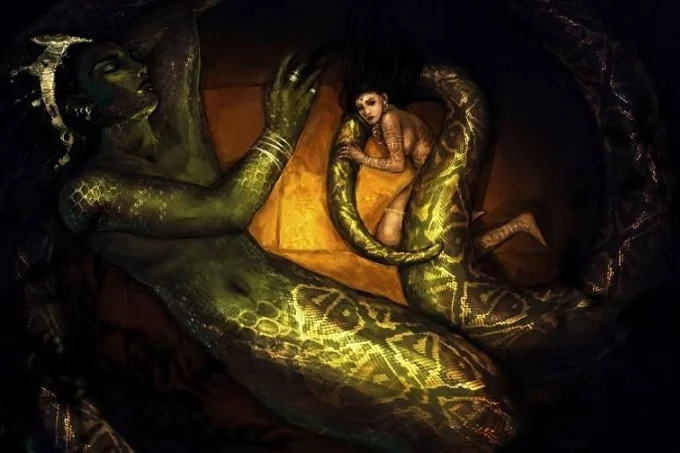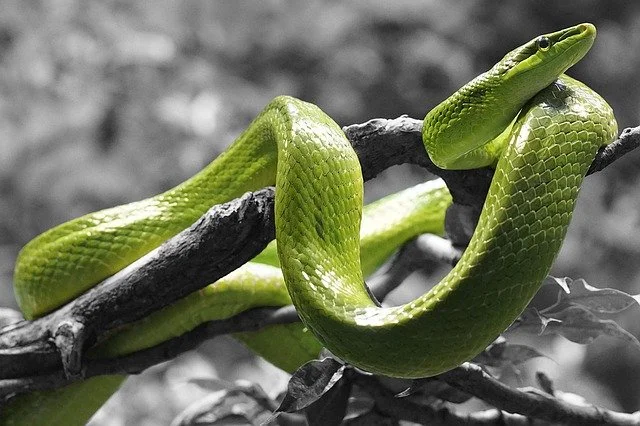Snake civilization in antiquity

Perhaps snakes elicit the most paradoxical emotions in us: dread and revulsion, as well as almost holy reverence… So, why did the snake acquire a sign of knowledge in the first place? And why does a snake, or rather, a Snake – a big, dreadful, and gifted with greater power – appear in practically every story concerning the origin of the world, in some form or another?
Many people have maintained myths about the global snake, who helped build our planet. The Vedas, for example, include the thousand-headed immortal snake Shesha, who churned the primordial ocean’s waters but was tamed by the deity Vishnu and coiled up in circles so that God may sleep quietly.
Vishnu has been resting on his snake bed ever then, but Shesha will spew toxic fire, destroy the planet, and awakened Vishnu will create new worlds one day.
According to the Evenks, the snake Dyabdar was transported to the Earth totally submerged in water. He crawled, laying riverbeds, and the water turned into rivers and oceans, then into the land.
The snake Ermungand, a figure from Scandinavian mythology, wraps himself around the Earth, and it is only owing to his efforts that the world remains weightless.
The snake not only took part in the holy event of world creation, but some cultures believe he also became the progenitor of the human species. Almost everyone is familiar with the Aztec deity Quetzalcoatl, the giant feathered serpent. People were molded out of clay by the snake goddess Nyuva, according to Chinese folklore.
The Hopi are known as the “Children of the Snake,” and they are one of the most mysterious Indian groups. The holy patron of the Mongols is Avraga Mogoi, the snake from whence they sprung. Our forefathers sought to tame the snake by finding a snake nest near the home and transporting food and milk there.
Snakes “were adored by certain people as home gods, they were sacrificed milk, cheese, eggs… It was illegal for everyone to cause damage to these creatures,” according to Russian ethnographer M.D. Chulkov. According to the Slavs, the snake, who is the patroness of the home, not only bestows knowledge to its obedient wards but also defends them from evil powers and wicked pranks.
“Nagadvipa” – “the nation of the Nagas” – was the old name for India. Nagas, or knowledgeable snake people, could transform into humans, and snake ladies wedded kings and heroes. The Buddha is said to be from the Naga dynasty, according to certain accounts.
The snake, on the other hand, was a foe of the human race and the light deities in general. In Ancient Egyptian mythology, for example, the snake Apop was a deadly adversary of the sun god Ra, attempting to consume the luminary every morning so that darkness would be imposed on Earth forever. However, as you would expect, Ra always triumphed, and the sun rose over the horizon.

Don’t forget the Bible, too. The serpent-tempter is the epitome of total evil and the Creator’s perpetual foe: it was via his instigations that Eve picked the holy fruit, and humanity were driven from paradise to “earn their daily food by the sweat of their brow.”
Snakes in Indian mythology have nothing to do with people: a snake biting its own tail is a symbol of infinity and the universe’s endless movement.
In a nutshell, the snake is clever and kind in some mythology, yet harsh and reasonable in others… It represents the unending struggle between good and evil. But keep in mind that good and evil are human concepts, whereas the holy creature is above morality. The global serpent has a distinct mission: to preserve the cosmos.
The universe of reptiles
If doubters do not trust Darwin, who regarded monkeys to be our forefathers, the theory that humans originated from snakes is difficult to take seriously. Where does one get such a reverent attitude toward creepy crawlies?
To begin with, it’s likely that snakes controlled the world when there were no humans around. Reptiles reigned for tens of millions of years. Cataclysms shook the world, causing climatic change, the extinction of dinosaurs and other Earth species, the collapse of old civilizations, and the survival of snakes.
They didn’t simply remain; they established themselves in abandoned cities and monasteries, making it impossible for anybody who had previously visited there to return – snakes ruled supreme, preventing newcomers from approaching.
Biologists and paleontologists attribute the snake tribe’s “immortality” to a unique capacity to adapt. Snakes have preserved the hidden knowledge of esotericism from the beginning of time. In some manner, these far from toughest and hardiest creatures “crawled” into a new period – and saw the advent of humans with their own eyes, awful, unblinking, with vertical pupils.
This seems to be mirrored in mythology from the past. Our forefathers both feared and revered snakes, whose bites are venomous and whose embraces are lethal: the snake may actually pour on the ground, then hide in the long grass, then reappear; she can easily climb a tree; and many snakes have extremely beautiful colors… All of these snake “talents” showed that snakes aren’t just regular animals but members of an ancient race. As a result, legends arose.
Defeat the dragon!
A man was fast acclimating to his new surroundings. The offspring of the global snake dispersed into tunnels and dungeons, laying down at the sea’s bottom, carrying the valued wisdom with them.
People have gained freedom, but they have lost how to communicate in the old tribe’s language, which is the language of knowledge. Of course, they realized what was going on, but it was too late: snakes are notorious for guarding their valuables.
Treasures were formerly thought to be a kind of hidden knowledge that could only be mastered by an initiate: according to tradition, snakes would willingly deliver the treasure to someone who has completed all of the tests. However, when the number of initiates dwindled, individuals began to forget what their former clients were defending.
As a result, snakes are said to protect mostly money and valuables in subsequent stories. So there came a vision of a monster lurking under the frost, protecting jewels strewn around.
So, the Christian interpretation of the snake figure is not far away: he is a symbol of sin, the embodiment of the devil. Ancient myths and fresh layers of tales collide once more: the snake is revealed to be the dragon’s closest cousin (but snakes have seen genuine dragons, dinosaurs, and pterodactyls!).
And killing the snake becomes a question of pride. He is the one who gets speared by George the Victorious. The serpent gets stomped by Peter the Great’s horse’s foot – recall the renowned Falcone monument? A person kills evil, fights wickedness, and praises the Lord by slaying a snake. Despite this, Serpent Tugarinovich, nagi, and Quetzalcoatl are not forgotten probably because mankind has held on to the concept that the mythological big snake guards the mysteries of the cosmos. Krishna is dancing on top of the Kaliya serpent, and the snake’s wives are praying to him.
There is a theory that the serpentoid civilisation came before humanity (from the Latin serpenta – “snake”). The “snake race” initially arose during the Mesozoic epoch, when reptiles reigned supreme.
The idea is based on the discovery of fossilized Stenonychosaur remains. After studying them, Canadian paleontologist Dale Russell concluded that the brain size of these creatures expanded at the same rate as that of man’s ape-like predecessors. As a result, they have a good chance of becoming clever!
Serpentoids were beings who stood less than one and a half meters tall, had scales on their bodies, and limbs that resembled human hands and feet but were three-toed. The temperature changed considerably throughout the Cretaceous epoch, and the serpentoids went extinct. This is also only a hypothesis: scientists are currently debating the reasons for dinosaur extinction and the extinction of other early occupants of the planet.
The fast development of mammals is still a mystery since there is no rational explanation for it.



